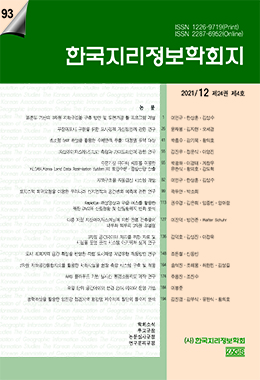본 연구에서는 LIS(Land Information System)를 기반으로 구축된 K-LIS(Korea-Land surface Information System)의 KLDAS(Korea Land Data Assimilation System)를 사용하여 남한 전역을 대상으로 토양수분 및 증발산량을 산출하였다. K-LIS를 구동하고, KLDAS를 구축하기 위해 사용된 수문기상 데이터 세트는 MERRA-2(Modern-Era Retrospective analysis for Research and Applications, version 2), GDAS(Global Data Assimilation System) 그리고 종관기상관측(ASOS, Automated Synoptic Observing System) 자료이다. ASOS는 지점 자료이므로 KLDAS에 적용하기 위해 0.125°의 공간해상도를 가진 격자형 자료로 변환하였다(ASOS-S, ASOS-Spatial). KLDAS에 적용된 수문기상 데이터 세트를 지상관측자료(ASOS)와 비교한 결과 ASOS-S, MERRA-2, GDAS의 R2 평균은 각각 온도(0.994, 0.967, 0.975), 기압(0.995, 0.940, 0.942), 습도(0.993, 0.895, 0.915), 강우량(0.897, 0.682, 0.695)으로 분석되었다. 또한, 토양수분의 R2 평균은 ASOS-S(0.493), MERRA-2(0.56), GDAS(0.488)이며, 증발산량의 R2 평균은 ASOS-S(0.473), MERRA-2(0.43), GDAS(0.615)로 분석되었다. MERRA-2, GDAS는 다수의 위성 및 지상관측자료를 활용하여 품질관리된 데이터 세트인 반면, ASOS-S는 103개 지점의 관측자료를 사용한 격자 자료이다. 따라서, 관측자료간 거리 차이로 인한 오차가 발생하여 정확도가 낮아진 것으로 판단되며, 향후 ASOS보다 많은 지점의 관측자료를 확보하여 적용한다면 격자화로 인한 오차가 줄어들어 정확도가 높아질 것으로 판단된다.
In this study, soil moisture and evapotranspiration were calculated throughout South Korea using the Korea Land Data Assimilation System(KLDAS) of the Korea-Land Surface Information System(K-LIS) built on the basis of the Land Information System (LIS). The hydrometeorological data sets used to drive K-LIS and build KLDAS are MERRA-2(Modern-Era Retrospective analysis for Research and Applications, version 2) GDAS(Global Data Assimilation System) and ASOS(Automated Synoptic Observing System) data. Since ASOS is a point-based observation, it was converted into grid data with a spatial resolution of 0.125° for the application of KLDAS(ASOS-S, ASOS-Spatial). After comparing the hydrometeorological data sets applied to KLDAS against the ground-based observation, the mean of R2 ASOS-S, MERRA-2, and GDAS were analyzed as temperature(0.994, 0.967, 0.975), pressure(0.995, 0.940, 0.942), humidity (0.993, 0.895, 0.915), and rainfall(0.897, 0.682, 0.695), respectively. For the hydrologic output comparisons, the mean of R2 was ASOS-S(0.493), MERRA-2(0.56) and GDAS (0.488) in soil moisture, and the mean of R2 was analyzed as ASOS-S(0.473), MERRA-2(0.43) and GDAS(0.615) in evapotranspiration. MERRA-2 and GDAS are quality-controlled data sets using multiple satellite and ground observation data, whereas ASOS-S is grid data using observation data from 103 points. Therefore, it is concluded that the accuracy is lowered due to the error from the distance difference between the observation data. If the more ASOS observation are secured and applied in the future, the less error due to the gridding will be expected with the increased accuracy.




